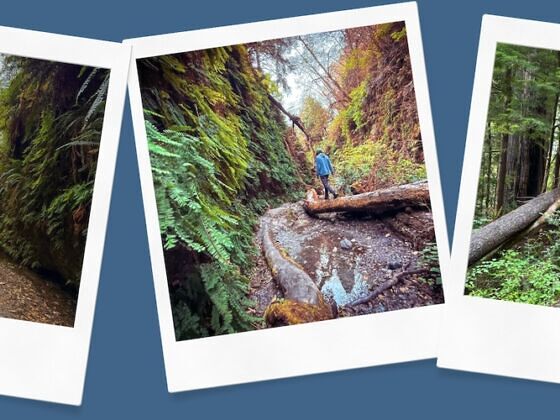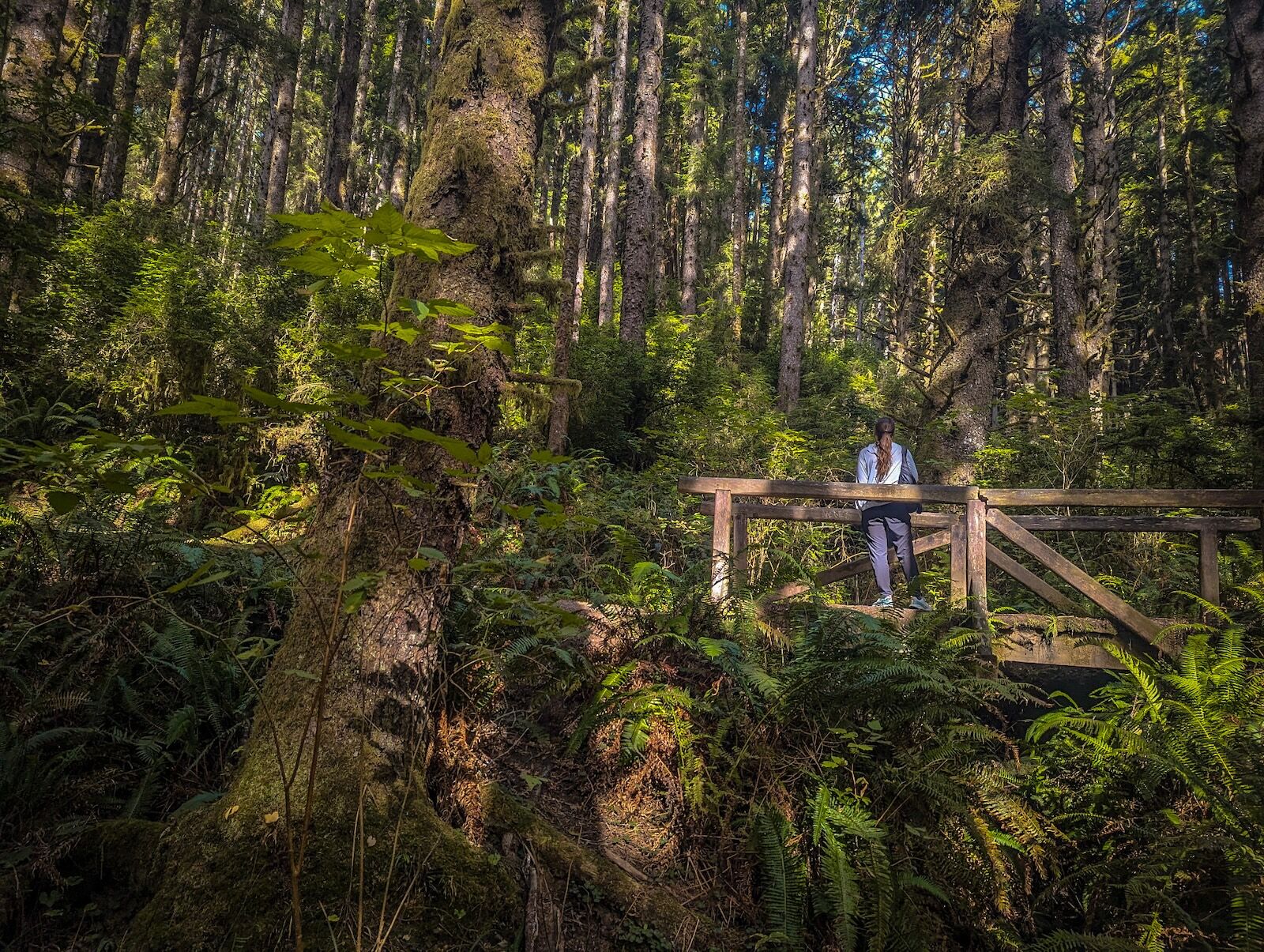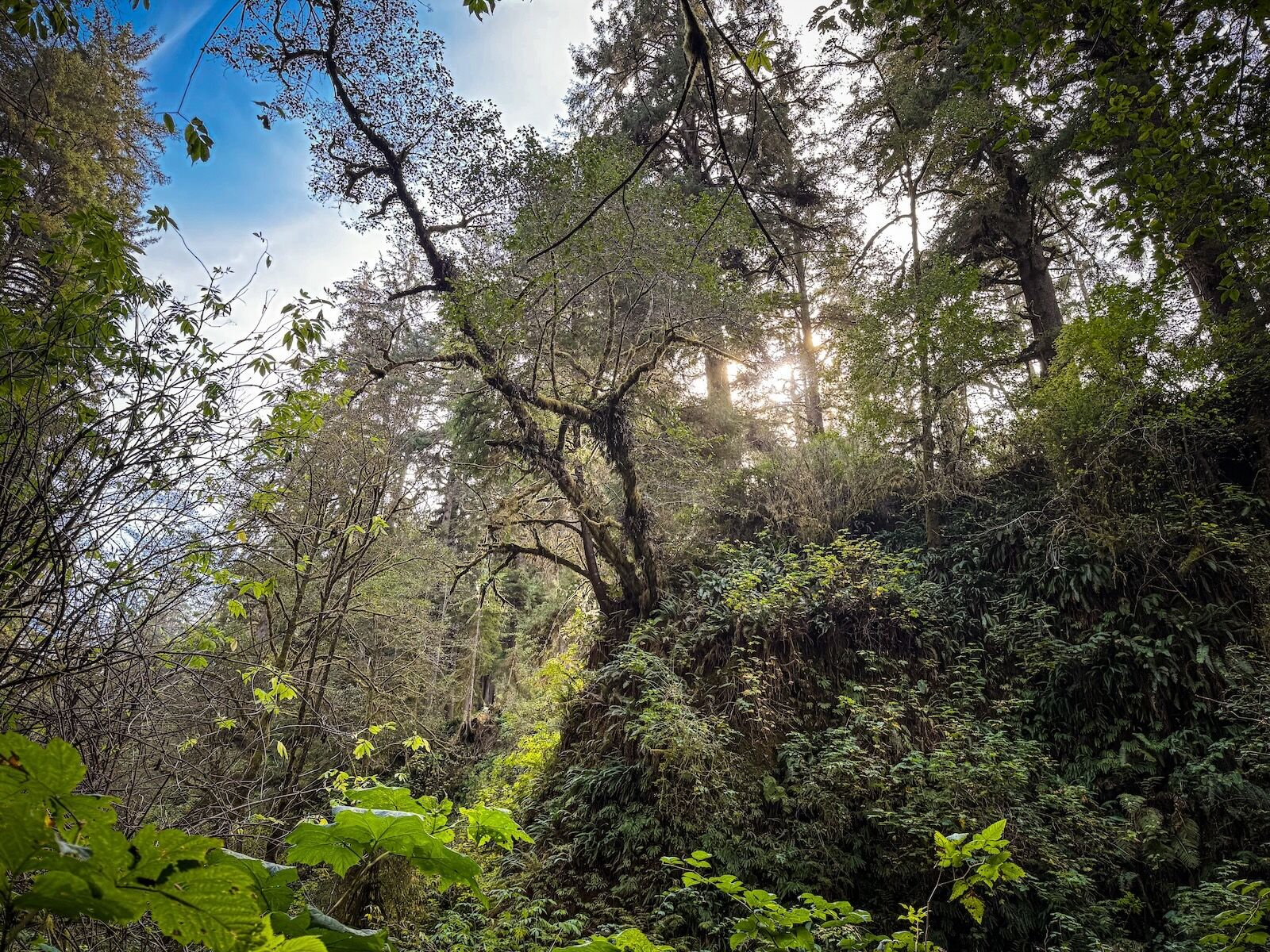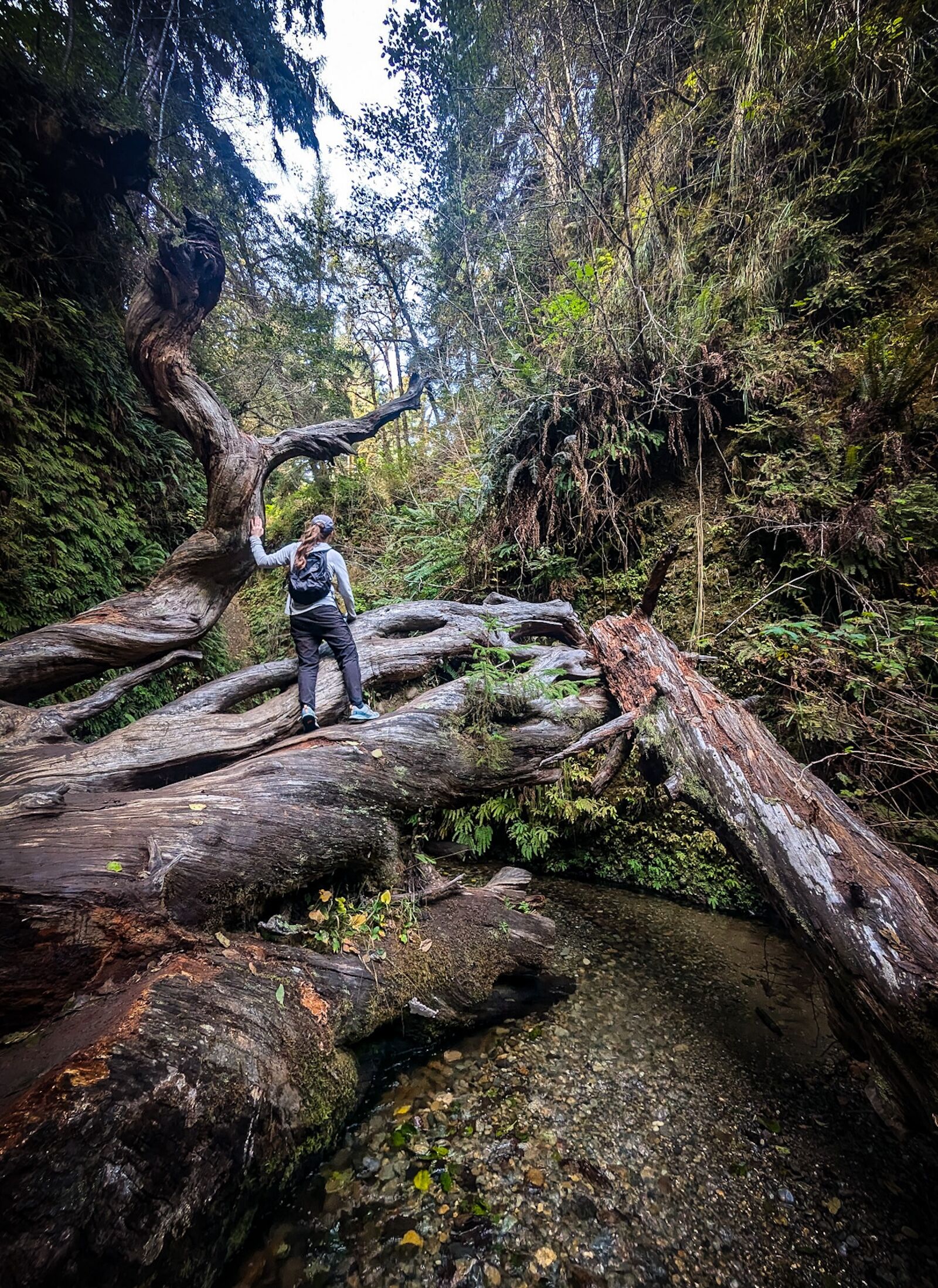Fern Canyon, deep within Northern California’s Prairie Creek Redwoods State Park, is a rare natural marvel — but not one that has escaped attention from travelers in recent years. Though it’s at the end of a long rutted road in Humboldt County’s coastal wilderness, the narrow gorge is so popular with hikers that the park introduced a permit system in 2022, requiring anyone who wants to access the road to the canyon to apply online for one of 150 Fern Canyon passes.


Camera Roll: California's Epic Fern Canyon Trail Feels Like Traveling Back in Time
The permit system is a welcome addition, limiting the number of people who can access the canyon each day to protect its fragile ecosystem, but still allowing those who plan in advance to enjoy the uniqueness of the natural wonder.
And natural wonder it is. It’s defined by 60-foot walls blanketed in dense, emerald ferns, and is an environment that has endured for millennia. It’s a cool, damp climate, where mosses, lichens, and ferns thrive in layers of green. The prehistoric, otherworldly feeling has even earned it a place on the big screen — most notably as a backdrop for The Lost World: Jurassic Park.
Getting to the Fern Canyon Trail
Fern Canyon is a short and quick hike, but getting to the trailhead will take some planing. Aside from needing a permit during the summer months, you’ll also need to get to the trailhead, which is a roughly six-mile drive along a muddy, rutted road. You’ll want an AWD or 4WD vehicle, and be prepared to drive through a few small stream crossings, as well as some significant potholes — some experience off-road driving will make the process a bit faster. There’s no cell service, and while there are pit toilets at the trailhead, there’s no water.
Be sure to have either a CalParks pass, an America the Beautiful national parks pass, or $12 in cash to pay the entrance fee at the gate about halfway up the road. The parks are in a remote part of northern California, so you’ll need to make it an overnight trip. You’ll want to stay in nearby towns like Arcata, Crescent City, or Orick, or rent an Airbnb closer to the trailheads.
The closest major airport is Oakland, CA (about a six-hour drive), though there is a small airport in Arcata, CA, in Humboldt County, that connects to Denver, LA, and SF. Regardless of where you stay, you’ll need to rent a car. Fortunately, the whole northern California coast is a perfect place to road trip, especially if you continue up the coastline through Oregon and Washington state.
Here’s what it’s like to explore the Fern Canyon Trail, an amazing hike even if you couldn’t care less about dinosaurs (or ferns).

The first thing you’ll see on the trail is an elk warning sign. This part of California is home to protected Roosevelt elk, who can be slightly more aggressive during the mating season (autumn). While we didn’t see any on the trail, I would have liked to — the visual of seeing the large creatures wandering through the lush canyon would have been beautiful. We did see plenty of elk in herds in other areas of the park later that day, though. Photo: Suzie Dundas

The hike to Fern Canyon is quite beginner-friendly. The shortest option for an actual hike is the one-mile loop trail, which is what we did. It gains only about 100 feet of elevation and goes through a lush, jungle-esque forest where the ferns seem to grow larger and larger with each step forward. Visitors with mobility issues can walk even less, as you can access the widest part of the canyon after just one quarter of a mile of hiking, allowing you to skip the one-mile hike through the canyon. For a longer option, you can take the 12-mile James Irvine Trail, starting and ending at the Prairie Creek Visitor Center. It’s an all-day hike, and a great option if you couldn’t snag a permit for the Fern Canyon Trailhead. Photo: Suzie Dundas

The Fern Canyon Trail and canyon itself are mostly in shadows, but I visited on a sunny fall day when dapples and bursts of light would often make it through the dense canopy. Just before I entered the canyon, a burst of sunlight made me squint, and I turned around to see where it came from up (spoiler: the sky). When I looked back, I noticed this large tree silhouetted against the sky, and the wild nature of the overgrown scene made me excited for fully entering the canyon. I’m a huge fan not just of the Jurassic Park movies and dinosaurs in general, but also a huge fan of protecting wild, natural places that remind us of what the planet was like hundreds of thousands of years ago, before humans started making an impact. Photo: Suzie Dundas

You’ll know when you’re starting the descent into the canyon, as the terrain gets slipperier and muggier. While the climate is cool around Fern Canyon, it’s certainly not cold. It’s a temperate rainforest climate, characterized by cool, damp conditions year-round. The park’s proximity to the Pacific Ocean (just a few minutes’ walk from the canyon) plays a crucial role, creating a mild climate with significant rainfall. Fog (a defining feature of the coastal redwood ecosystem, as anyone who has visited knows) frequently blankets the park, especially during the summer, keeping conditions consistently moist and maintaining the high humidity levels needed to support greenery and lush undergrowth year-round. Photo: Suzie Dundas

There’s a long stream that runs through Fern Canyon, and you should probably expect to get your feet wet. In the fall, the park transitions from dry to wet conditions, with sporadic rainfall beginning as early as late September. Fall rain can slightly raise the water levels, but are generally mild compared to winter downpours. During the wet season, the park’s trails, especially those leading into Fern Canyon and along the canyon floor, can become flooded and slippery. The park installs temporary wooden footbridges from late spring to early fall to help visitors navigate the stream crossings without getting soaked, but outside of that, you’ll need to do a lot of rock stepping or jump over streams. Or better yet, be like me: just get your feet wet, and that way, you can walk wherever you want. Photo: Suzie Dundas

Fern Canyon’s steep, moisture-rich walls host a striking diversity of ferns, creating a lush tapestry of prehistoric flora. There are at least five species of ferns growing along the canyon walls, each contributing to the sense of stepping back into a primeval landscape. That includes five-finger ferns, sword ferns (which can grow up to five feet wide), lady ferns (which have a more delicate, lace-like appearance), deer ferns, and chain ferns. The canyon’s ferns are remnants of the prehistoric vegetation that once covered much of North America during the age of the dinosaurs. The dense fern cover also contributes to the canyon’s microclimate, helping to maintain humidity and moderate temperature extremes. Photo: Suzie Dundas

Be prepared to do a bit of scrambling if you walk through the canyon. During my visit, there were large logs like this one, as well as smaller downed trees, slippery crossings on rocks and branches, and plenty of uneven and moss-covered terrain. You’ll want to wear shoes with a good grip, and maybe bring a hiking pole if you’re very concerned about tripping or getting wet. However, I saw lots of people of all ages exploring the canyon, including several people with canes just making the short walk to the mouth of the canyon. You may have to do a bit of ducking or weird stepping to go through the Fern Canyon Trail, but you don’t need to train or be an experienced hiker in any way. Photo: Suzie Dundas

The Fern Canyon Trail was busy during my midweek October visit, but not wildly so. We arrived around 1:30 PM (likely the busiest part of the day) and found plenty of parking. We didn’t see anyone on the start of the one-mile loop on the section of trail before the canyon, and probably saw about 30 or so people while we were making our way through. While the Fern Canyon Trail does get busy in the summer (hence the permit system), it wasn’t too bad for us, and we never had to wait in lines for stream crossings or wait more than a minute or so for an area to clear out to take photos. Photo: Suzie Dundas

Several Hollywood movies have used Prairie Creek Redwoods State Park and its surrounding areas as natural backdrops, drawn by the region’s primeval forests, misty coastal landscapes, and dramatic canyons. Among the most notable films shot here is The Lost World: Jurassic Park (1997), which famously featured Fern Canyon as part of its depiction of an untamed, dinosaur-filled world. It really does look like a dense, prehistoric jungle, making it the perfect stand-in for the fictional island of Isla Sorna — an island supposedly owned by the proprietors of the failed Jurassic Park and teeming with dinosaurs. While I wasn’t lucky enough to spot a dinosaur, it’s still amazing to walk through the canyon and know that’s what parts of the planet looked like millions of years ago. Photo: Suzie Dundas

Fern Canyon formed through geological and hydrological processes driven primarily by erosion from Home Creek. The canyon’s steep walls are composed of sandstone and shale uplifted millions of years ago by tectonic activity along the Pacific-North American Plate boundary. As the land rose, it became susceptible to erosion, and snow and rain that fed the creek became the carved the canyon’s deep, narrow channel over eons. It’s thought that the canyon probably started eroding 10,000 to 12,000 years ago, and the process is still continuing today. Now, the walls are more than 60 feet high in some places — but with trees lining the top of the canyon, it feels much taller when you’re standing at the bottom looking up. Photo: Suzie Dundas

The parking area for Fern Canyon is just a minute or two by car from Gold Bluffs Beach, a rugged, windswept stretch of sandy shoreline running parallel to the coast. Named for the gold-colored cliffs that rise above it, the beach’s history is rooted in the California Gold Rush, when prospectors briefly mined its sands for traces of gold in the mid-19th century and named the shoreline for the nearby golf-colored cliffs. Today, it’s known for its scenic beauty, offering miles of wide, soft, and clean sand framed by grassy dunes and coastal scrub. It’s often foggy and overcast, giving it a mystical, almost otherworldly feel, especially at dawn and dusk. You can often see Roosevelt elk as well as shorebirds like sandpipers, gulls, and the occasional pelican. The beach is also a good spot for whale watching during migrations, particularly in late winter and early spring. If you visit, bring a sweater — it’s not as warm as your average California beach. Photo: Suzie Dundas

Prairie Creek State Park — and all the other state parks nearby — are known for their towering redwood and sequoia trees. While there are redwoods near Fern Canyon, they’re not as towering as those in other parts of the park. (But you will drive past some on the road to the Fern Canyon Trailhead). To hike beneath giant redwoods, you’ll need to go elsewhere nearby. This is the Tall Trees Grove Trail (which also requires a permit), part of Redwood National and State Parks. Redwoods in this part of the park can grow up to 380 feet tall; in fact, it’s where famously tall trees like Hyperion and Helios are still growing. If you can’t manage to get a permit to hike the Tall Trees Trail, or don’t have time to drive all the way to the trailhead, consider hiking through the LadyBird Johnson Redwood Trail. It’s only about 1.5 miles off of Highway 101, whereas the Tall Trees Grove is an eight-mile drive along a rough private road. Photo: Suzie Dundas